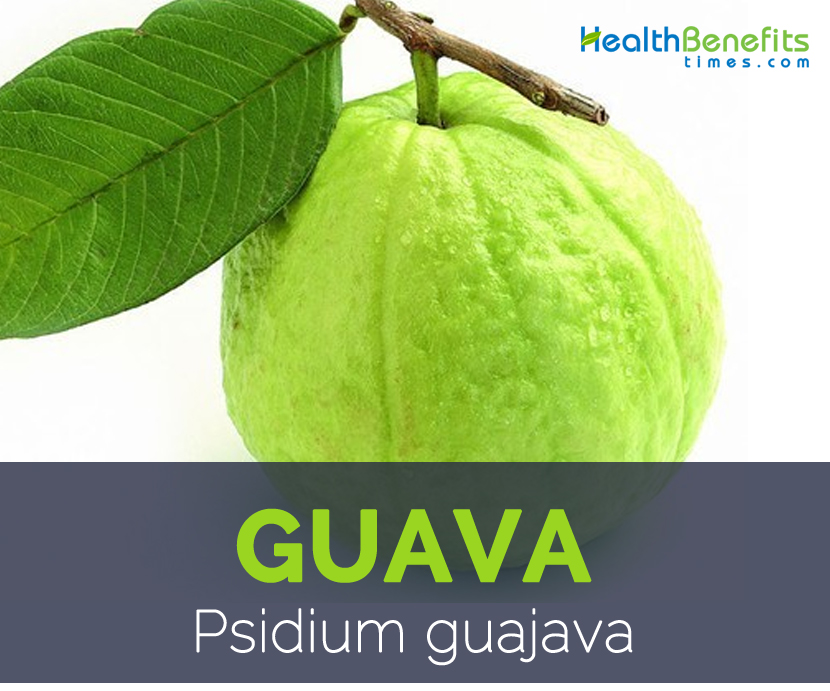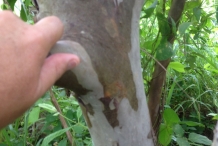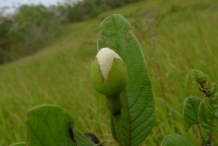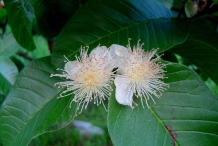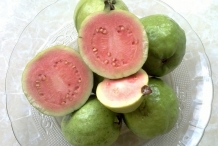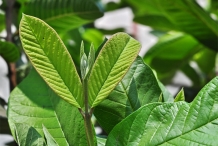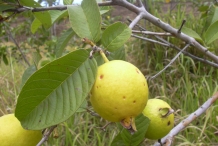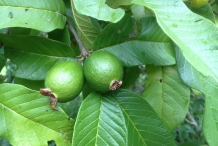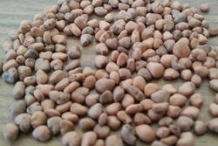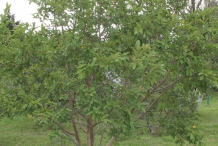Plant
Guava is an evergreen, tropical shrub or low-growing small tree, 8–10 m high with smooth grayish brown bark that peels off in strips, spreading branches and quadrangular, pubescent branchlets. Guava plant normally grows in areas with a tropical or equatorial climate. It also grows well in the warm, sub-arid, savannah areas as it is quite drought tolerant but adequate irrigation is necessary for good growth and high yields. It can tolerate many soil conditions, but will produce better in rich soils high in organic matter. They also prefer a well-drained soil. The tree will take temporary waterlogging but will not tolerate salty soils.
Leaves
Leaves are opposite, ovate-elliptic or oblong elliptic, acute-acuminate, pubescent beneath, rough adaxially, prominent midrib impressed, lateral nerves 10–20 pairs; blades mostly 7–15 cm long and 3–5 cm wide, rounded at base, apex acute to obtuse, dull green.
Flowers
Flowers are usually fragrant, white, large, 2.5 cm across, solitary or 2 or 3 in axillary cymes. Peduncle 1–2 cm long, pubescent. calyx 4–5-lobed, 6–8 mm long, persistent on fruit; petals white, 10–15 mm long, fugacious, usually 4 or 5, obovate, slightly concave; stamens numerous (200–250), white, about as long as petals with pale yellowish anthers; style 10–12 mm long, stigma peltate.
Fruit
Guava fruits may be round, ovoid or pear-shaped, 3–10 cm long and weighs around 50–200 g, and have 4 or 5 protruding floral remnants (sepals) at the apex. The fruit is green while young turning to whitish yellow or faintly pink when ripe. Varieties differ widely in flavor and seediness. The better varieties are soft when ripe, creamy in texture with a rind that softens to be fully edible. The flesh may be white, pink, yellow, or red depending on the cultivar. The strong, sweet, musky odor is pungent and penetrating with sweet tart taste. Fruit consists of numerous tiny, yellowish, reniform, semi-hard edible seeds, concentrated especially at its center. Some varieties are seedless. Actual seed counts have ranged from 112 to 535. The quality of the fruit of guavas grown in cooler areas is often disappointing.
There is a completely maroon-colored cultivar with maroon branchlets and leaves, crimson flower with crimson stamens and maroon fruit with maroon-colored flesh. Guava starts to produce fruit 2 to 8 years after planting. Fruit has strong, lemon-like musky odor. Rind can be bitter or sweet, while flesh has creamy texture and sweet-tart taste. Under the optimal climate conditions, guava produces fruit two times per year. Guava is perennial plant that usually lives around 40 years.
History
Guavas are native to Mexico, Central America and the north of South America. Historians show that these fruits were originally cultivated in tropical America, possibly Brazil, but were improved in the West Indies. At the start of the 16th century, the Portuguese introduced guavas all around the Pacific, till it reached the Philippines. A few years later, the Spanish brought this delicious fruit to India. Early Spanish travellers, in the 1500s, discovered the Strawberry Guava as a tree native to America. Records prove that Seminole Indians grew this fruit widely in Northern Florida around 1816. Progressively, it became popular and spread to other parts of the world. Since 1950, guavas have become a major subject of research in order to decipher the chemical identity of its constituents, pharmacological properties and its history in folk medicine. The fruit is now commercially cultivated in Southeast Asia, Hawaii, the Caribbean, Florida and Africa.
Bioactive Compounds Present in Guava Fruit
- Carotenoids
Carotenoids are organic pigments that naturally occur in the chromoplasts of plants. Guava fruit has been reported to contain several carotenoids, such as β-carotene, β-cryptoxanthin, lycopene, and lutein. Setiawan et al. reported that guava is an excellent source of carotenoids, a precursor of vitamin A. However, the scarcity of literature about carotenoids in guava makes this an area with potential for further research development.
- Polyphenols
Tropical fruits, such as guava, have proven to be a major source of polyphenols (PPs). It is reported a PP content of 5480 mg gallic acid equivalents per 100 g dry weight (dw) in guava. However, this value can differ between studies and varieties, because it is dependent on the ripening stage and the crop conditions.
- Triterpenes
Some other BCs identified in guava fruit are triterpenes, which are mainly sesquiterpenoids, such as abscisic acid, pedunculoside, guavenoic acid, and madescassic acid. Some reports have identified other terpenoid compounds, like limo nene, β-caryophyllene, β-gurjunene, and α-humulene), in guava fruit. Guava leaves have been reported as containing guajavanoic acid, obtusinin, and goreishic acid. However, information about the terpenes in guava fruit is scarce, and even less is known about the potential functional proper ties that the presence of these compounds can exert in human health. It would be of interest to explore the possibility that these terpenoids can influence certain metabolic states by regulating inflammatory pathways, as has been demonstrated for guava leaves.
- Volatile Compounds
One of the main features of guava fruit, in addition to its flavor, is its characteristic aroma, which is determined by the volatile compounds found in the fruit. Thuaytong and Anprung reported 28 volatile compounds in guava, identifying mainly terpenes and terpene derivatives. The major compounds identified were α-copaene, β-caryo phyllene, aromadendrene, α-humulene, alloaromaden drene, α-bisabolene, δ-cadinene, and (Z)-α-bisabolene. These compounds are related to the characteristic aroma of tropical fruits. It is studied the aromatic profile in commercial guava by GC-MS, and identified a total of 51 components as the main components of guava puree and fresh fruit.
- Guava Fruit Matrix Interactions
Guava fruit has very complex matrices, within which may be different interactions between components. The dietary fiber and polyphenols in guava fruit have been studied separately and have different functional properties. In the case of the PPs present in guava, they may be associated with the DF matrix, either the soluble or insoluble fractions, by covalent bonds or hydrophobic interactions. The PPs show both hydrophobic and hydrophilic rings with hydroxyl groups, with the ability to bind polysaccharides, proteins, or various sites in the cell wall. This is important from a nutritional point of view, since the components associated with DF may be responsible for some benefits traditionally attributed only to DF consumption. To exert the biological activity of absorption and metabolism of the PPs, the action of digestive enzymes that affect their bioavailability must be taken into account.
Nutritional Value
Apart from their sweet-tart taste, guava is a good source of nutrients, vitamins and minerals. Consuming 165 gram of guavas offers 376.7 mg of Vitamin C, 8587 µg of Lycopene, 0.38 mg of Copper, 8.9 g of Total dietary Fiber, 81 µg of Vitamin B9 and 23.63 g of Carbohydrate. Moreover many Amino acids 0.036 g of Tryptophan, 0.158 g of Threonine, 0.153 g of Isoleucine, 0.282 g of Leucine, 0.119 g of Lysine, 0.026 g of Methionine and 0.01 g of Phenylalanine are also found in 165 gram of guavas.
Health benefits of Guavas
Guava fruit is a wonderful method of obtaining vitamin C and is also a pleasant exotic option to the orange or even grapefruit. Try out developing a fruit salad making use of this amazing fruit or even make use of a juice machine to create refreshing guava juice. Guava fruit is provided in certain standard food markets as well as the juice are available in several natural super markets.
Guavas really are a treasure-trove of nutrition. It is referred as one of many “Super foods” as it is loaded with huge amount of anti-oxidants. Also, they are recognized for their higher pectin content. Listed below are some of the popular health benefits of consuming guava:
1. Weight loss
Guava is quite helpful for those who want to lose weight without compromising their intake of proteins, vitamins and fiber. Guava is good source of roughage and rich in vitamins, proteins and minerals, but it has no cholesterol and a low number of digestible carbohydrates. It is a very filling snack and satisfies the appetite very easily. Guava, particularly raw guava has far less sugar as compared to apples, oranges, grapes, and other fruit. Including a medium-sized guava to your lunch and you will not feel hungry again until the evening. Ironically, it can also help with weight gain in lean, thin people. This is perhaps due to its wealth of nutrients, which keep the metabolism regulates and helps to promote the proper absorption of nutrients.(1)
2. Immunity
Guava is an excellent source of Vitamin C. It contains 337 mg of Vitamin C which is equal to 628% of RDA required in the daily diet. A guava a day can restore the loss of this vitamin completely.
Vitamin C also acts as an antioxidant and help to increase immune system function of our body. It is known to develop resistance in the body against common diseases like a cough, cold and flu.
Vitamin C as an antioxidant contributes in maintaining a good skin health by cleaning the body off the free radicals and other impurities thus delaying skin ageing. It also plays a significant role in growth and repair of body tissues. In studies, it was found to quicken healing of scars and wounds.(2), (3), (4)
3. Eye & Skin Health
Vitamin A is one of the powerful antioxidant and is recommended for improving eye health. It acts as a barrier between the vulnerable eye parts and the potential bacterial and viral infections.
Apart from that it has been found to be effective in avoiding retinal damage caused due to free radicals by removing them from our system regularly. Therefore, it improves eye vision and protect from cataract.
Another common eye condition macular degeneration is efficiently undertaken by Beta Carotene in combination with other anti-oxidants in Guava.(5), (6), (7)
4. Beats Toothache
Guava leaves have a powerful anti-inflammatory and antibacterial ability which fights infection and kills germs. Therefore, consuming guava leaves works as a wonderful home remedy for toothache. The juice of guava leaves has also been known to cure toothaches, swollen gums and oral ulcers.
5. Thyroid Health
Guava is a good source for copper, which is an important part of regulating thyroid metabolism by helping to control hormone production and absorption. The thyroid gland is one of the most important glands in the body for regulating hormones and organ system function, so guava can help balance your health in many ways.(8)
6. Eyesight
Guavas are extremely good sources of vitamin A, which is well known as a booster for vision health. It helps to slow down the appearance of cataracts, macular degeneration, and general health of the eyes. It cannot only prevent degradation of eyesight, but even an improvement in eyesight once it has begun to degrade.
7. Cancer Prevention
Frequent consumption of guava is quite beneficial to inhibit the growth and metastasis of cancerous cells. Guava leaf oil is extremely successful as an anti-proliferative substance, and has shown to be more effective compared to leading modern medicines in reducing cancerous growth. Similarly guavas are rich in lycopene, a powerful antioxidant that has been shown to be wildly successful in decreasing prostate cancer risk. That same antioxidant has also shown to inhibit the growth of breast cancer cells, although further human trials need to be done.
Apart from that higher level of vitamin C in guavas, provides the immune system a huge boost in antioxidants. Antioxidants are actually the major lines of defense against the proliferation of free radicals in the body, which are one of the main causes of serious conditions like cancer and heart disease. Therefore, adding guava to your diet has numerous ways in which it helps you stay health and cancer-free.(9), (10), (11)
8. Diarrhea & dysentery
Guava is very rich in astringents (compounds that make your gums feel tighter and fresher). When you chew guava leaves, eat a raw guava, or use some guava-based toothpaste, your mouth feels healthier, and the astringent qualities also add substance to loose bowels as well as reduce symptoms of diarrhea. These astringents are alkaline in nature and have disinfectant and anti-bacterial properties, therefore helping to cure dysentery by inhibiting microbial growth and eliminating extra mucus from the intestines. Additionally, other nutrients in guava such as vitamin C, Carotenoids and potassium, strengthen and tone the digestive system while simultaneously disinfecting it. Guava is also beneficial in treating gastroenteritis for the same reasons stated above.
9. Controls Diabetes
Several researches have concluded that fiber rich guava consumption help to reduce the absorption of sugar in the body. Guava consists of good amount of dietary fiber that is known to decrease the chances of Type II diabetes considerably. Frequent consumption of fiber rich food also reduces sugar spikes in a diabetes patient.
Apart from that guava has lower glycemic index which makes it an effective fruit against the excessive sugar absorption in the body. Similarly high amount of Vitamin C ensures that there is regular and effective flushing out from the body that helps in effective diabetes management.(12), (13)
10. High blood pressure
Guava helps to reduce cholesterol in the blood and prevents it from thickening, thus maintaining the fluidity of blood and decreasing blood pressure. Research has shown that food lacking fiber (such as refined flour) add to blood pressure, due to its quick conversion to sugar. Guava, being very rich in fiber and hypoglycemic in nature, helps reduce blood pressure.(14)
11. Constipation
Guava is one of the best sources of dietary fiber in terms of fruit. Its seeds, when ingested whole or chewed, serve as outstanding laxatives. These two properties of guava help the formation of healthy bowel movements, and aid the body in retaining water and systematically cleaning your intestines and excretory system. It is said that constipation alone can result in 72 different types of ailments, so any help with constipation is beneficial. Your total health is undeniably affected by proper digestion, and more importantly, proper excretion. Frequent consumption of guava can ensure both.(15)
12. Brain Health
Guavas consist of good amount of vitamin B3 and vitamin B6. B3 (also known as niacin) help to increase blood flow and encourages cognitive function. B6 is a great nutrient for brain and nerve function. Therefore, frequent consumption of guava can help you increase brain function and sharpen you focus.(16)
13. Cough & cold
Juice of raw and immature guavas or a decoction of its leaves is quite beneficial for relieving coughs and colds by reducing mucus, disinfecting the respiratory tract, throat and lungs, and inhibiting microbial activity with its astringent properties. Guava has one of the highest quantities of vitamin C and iron among fruits, and both are proven to be preventive against colds and viral infections. In certain areas of India, roasted ripe guava is normally used as a remedy against extreme cases of cough, cold, and congestion. Ripe guava should be avoided by people who are suffering from cough and cold, as it can worsen the problem, and one should also avoid drinking water immediately after eating guava as it can lead to a sore throat.(17)
14. Scurvy
Guava can surpass many other fruits, including orange and other citrus fruits, in terms of its concentration of vitamin C. Deficiency of vitamin-C can cause scurvy, and proper consumption of vitamin C rich food is the only known cure for that dangerous disease. Guavas consist of 5X more vitamin C than oranges, which are often heralded as the absolute best source of that beneficial vitamin.(18)
Benefits from Leaves (Tea and Extracts):
Guava leaves can also be used in multiple ways. The most common is by drying the leaves for tea, using the leaves to make an extract, or by simply chewing on them.
1. Antimicrobial and Antibacterial
Guava leaves have proven to be antibacterial, antifungal and antimicrobial when up against a number of invaders. Research concluded that the traditional uses for guava leaf are effective and successful as treatment for illness like cough, diarrhea, oral ulcers and inflamed gums.
Other researches have shown effective examples of antibacterial activity from the guava leaf in cases of bacteria-caused diarrhea, where antibiotics may not have been available. In folk medicine, guava leaves were even crushed and used on open wounds and ulcers.(19), (20)
2. Treat and Prevent Diabetes
Guava leaf has been used in traditional folk medicine to reverse diabetes naturally and specifically, treat type 2 diabetes in East Asia. Apart from the fruit being an overall healthy snack for diabetics, guava leaf extract can lower glucose levels in the blood and fight against type 2 diabetes. Drinking guava leaf tea can benefit diabetic and pre-diabetic persons, as it can improve diabetes symptoms and insulin resistance.(21), (22), (23)
3. Anti-Inflammatory
Guava leaf extract has anti-inflammatory qualities because of flavonoids present in the leaves. Inflammation is at the core of most illness and disease, and including foods and supplements that work as anti-inflammatories helps to keep body systems working properly.(24)
4. Prevent Fatty Buildup in Arteries
Because of guava leaf’s anti-inflammatory and anti-oxidative features, it is a strong fighter against atherogenesis. The tea leaves prevent an enzyme responsible for the onset of atherogenesis. This condition can lead to numerous other cardiovascular issues.(25)
5. Prevention of Gastroenteritis and Diarrhea
Guava leaf extract, tea or essential oil has shown exceptional results in handling infectious diarrhea. This method has been used in rural communities all over the world to treat gastrointestinal infections and illnesses and is successful because of the plant’s astringency.
There is not a definitive reason for why guava leaf can prevent and treat these issues, but it most likely has to do with guava’s antimicrobial and antibacterial capabilities.(26), (27), (28), (29)
How to Eat
- Raw fully mature and ripe, aromatic guavas are eaten out-of-hand, but are favored deseeded and served sliced as dessert or in fruit salads.
- Fruits are made into puree, marmalade, juice, guava cheese, canned, stewed, chutney, baked or utilized in pies, cakes, catsup, puddings, sauce, jam, jellies, guava butter, beverages, wine, relish, ice cream and other products.
- A stewed guava shell is one of the standard desserts throughout Latin America and the Spanish-speaking islands of the West Indies.
- Guavas are mixed with cornmeal and other ingredients to make breakfast-food flakes in South Africa.
- Some popular recipes are guava dumplings, guava sauce and stew guava slices in Pacific islands.
- Ripe guava, lemon juice, ground cinnamon (optional), margarine, flour, baking powder, sugar, salt and margarine are used to make guava dumplings.
- Special guava sauce is made from guava pulp, vinegar, onion, chopped chili, or ground pepper, garlic, ground allspice (optional) ground cinnamon(optional), ground cloves, sugar and salt.
- Stewed guava slices are boiled with guava juice and served hot or cold with coconut cream.
- Ripe guava fruit is used as a vegetable or seasoning for the Filipino sour stew or soup called “sinigang” in Philippines.
- Matured or firm ripe fruits are sliced and eaten chilled with a sprinkle of salt or more popularly with a sprinkle of finely ground, preserved dried plum called “Assam Boi” in Malaysia.
- Guava fruit can be preserved whole or in slices in vinegar and also used for making chutney.
- Dried guava slices are also dried and preserved with salt or sugar and consumed as snacks.
- Ready-to-use dehydrated guava products such as dehydrated guava slices and leather can be prepared from firm and ripe guava fruits.
- “Kampuchea” cultivar is processed into a much-relished, fresh, chilled guava juice drink in Malaysia.
- Ripe guava fruits are placed into porcelain jars and allowed to ferment into a beverage akin to a light wine in Taiwan.
- Ripe guava fruits are also processed into guava wine and brandy in India.
- Guava extract prepared from small and overripe fruits is used as ascorbic acid enrichment for soft drinks and various foods.
- Economically important guava food products are the processed juice or puree products which are canned or aseptically packaged, chilled or frozen, canned guavas and dehydrated guavas.
- Guava puree or pulp is the starting ingredient for a host of guava food products.
- It can be made into a nectar drink, fruit punch, syrup or used directly with commercial mixes for making ice-cream, sherbet, yoghurt, smoothies, guava cheese or guava paste.
- Guava syrup can be used on waffles, ice-cream, milkshakes and puddings.
- Neat guava puree or sweetened puree can be used for stews, puddings, bakery products like pastries and the unsweetened puree or pulp used as baby food.
- A baby-food manufacturer markets a guava-tapioca product in South Africa.
- By freeze drying or vacuum puff drying guava puree can be processed into dehydrated powder, a convenient source of vitamin C and pectin a thickening agent, dried guava powder was used to fortify Allied troops during the second World War.
- Guava nectar makes a delicious fruit drink.
- Clarified guava juice is made from puree or ripe fruits by removal of the pink color and insoluble solids.
- Clarified juice can be blended with other fruit juice, made into jelly or clarified nectar, heated and stored for future use.
- Guava juice can be processed into carbonated guava beverage.
- Guava jams and jellies are made from whole fruit ingredients but those made from puree give better quality products.
- Product similar to guava jam known as guava cheese or paste is made in Florida and the West indies.
- Guava cheese can also be made from ripe guava fruits.
- Dehydrated guavas may be reduced to a powder which can be used to flavor ice cream, confections and fruit juices, or boiled with sugar to make jelly, or utilized as pectin to make jelly of low-pectin fruits.
- Full-size and firm ripe guava fruit not ripe enough for table use are considered best for fruit canning.
- Fruits are peeled or lye-peeled, deseeded, halved, sliced or diced into cubes and packed in sugar syrup.
- Oil from guava seeds is used in salad dressings.
- Guava leaf tea consists mainly of the aqueous extract of guava leaves and also to a lesser extent the extract of peels of unripe guava fruit.
Other Traditional uses and benefits of Guava
- Roots, bark, leaves and immature fruits are used in folk medicine because of their astringency, are normally used to halt gastroenteritis, diarrhea and dysentery, throughout the tropics.
- Guava leaf tea has been approved as one of the Foods for specified Health Uses and is commonly used for diabetes in Japan.
- Leaves are used for diarrhea, stomach-ache and gastroenteritis and as vermifuge in Peninsular Malaysia.
- Decoction of leaves is used for skin complaints.
- Combined decoction of leaves and bark is given to expel the placenta after childbirth and as emenagogue.
- Leaf decoction is used for leucorrhoea, bark used for hystero-epilepsy in Indonesia.
- Leaves have been used as an antidiarrheal and anti-dysenteric; externally, they have been used as a deodorant of mouth odor in Thailand.
- Unripe fruit, the leaves, the cortex of the bark and roots – through more often the leaves only – in the form of a decoction are used for washing ulcers and wounds in Philippines.
- Bark and leaves are stated to be astringent, vulnerary, and when decocted, anti-diarrheic.
- Bark decoction is used in chronic diarrhea of children and sometimes adults; a decoction of the root-bark is recommended as a mouthwash for swollen gums and as local application in prolapses in India.
- Guava jelly is supposed as tonic for the heart and good for constipation and ripe fruit is good aperients.
- Leaves are chewed as remedy for toothache.
- Leaf infusion is recommended in India in cerebral ailments, nephritis and cachexia.
- An extract is given in epilepsy and chorea and a tincture is rubbed on the spine of children in convulsions.
- Guava leaf is an important ingredient in many Ayurvedic preparations, for diabetes and other ailments.
- Leaf decoction is taken as a remedy for coughs, throat and chest ailments, gargled to relieve oral ulcers and inflamed gums.
- Decoction of the flower buds is considered an effective remedy for diarrhea and flow of blood in Costa Rica.
- Fruit is considered anthelmintic and the leaves used as remedy for itches and decocted leaves are used for cleansing ulcers in Mexico.
- Decoction of the leaves is used as a vaginal and uterine wash, especially in leucorrhoea in Uruguay.
- Decoction of the young leaves and shoots is prescribed in the West Indies for febrifuge and antispasmodic baths, and an infusion of the leaves for cerebral affections, nephritis, and cachexia; the pounded leaves are applied locally for rheumatism; an extract is used for epilepsy and chorea; and the tincture is rubbed into the spine of children suffering from convulsions.
- Leaf extract have been used for diarrhea and for diabetes in Brazil.
Other Facts
- Guava tree provides a yellow to reddish, fine grained, compact, reasonably strong wood which is used for carpentry and turnery.
- Wood is used for spear handles, wood engravings and instruments, household and agricultural implements, tree nails, post for small houses, fence posts, fuel wood and charcoal in Peninsular Malaysia.
- It is valued for engravings in India.
- Guatemalans use guava wood to make spinning tops, and in El Salvador it is fashioned into hair combs.
- Leaves and bark are rich in tannin.
- Bark is used in Central America for tanning hides.
- Leaves are used by dyers in Pekan, Peninsular Malaysia to dye silk black; and in Indo-China, to dye cotton black and for dyeing mattings in Indonesia.
Types of Guava
1. Strawberry Guava (Psidium lucidum) :
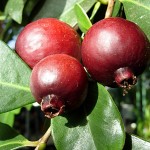 These types of Guavas are usually sturdy & flexible evergreen shrubs or even small trees. Small fruits are extremely succulent & tasty. The fruit are made on the long season August through December.
These types of Guavas are usually sturdy & flexible evergreen shrubs or even small trees. Small fruits are extremely succulent & tasty. The fruit are made on the long season August through December.
Strawberry guava (Psidium cattleianum) is indigenous to south eastern Brazil. It generally develops there in seaside plains as well as Atlantic forests approximately about 4,000 feet (1200 m) in height and is also from time to time grown just as one decorative fruit tree. In Brazil, strawberry guava usually ranges from 3 to 16 feet (1 to 5 m) tall, and its particular fruit is adjustable, yellow types being more prevalent as compared to red.
In 1825, strawberry guava was delivered to Hawaii because of its fruit as well as decorative characteristics. Now it is common on each of the main Hawaiian Islands in between sea level as well as 4,000 feet in height, particularly in landscapes which obtain reasonable to higher quantities of rain fall. The tree propagates by both shoots as well as seeds and also develops rapidly in Hawaii, owing partly towards the lack of the predators as well as diseases present in its indigenous Brazil. Nonnative birds as well as pigs, which usually take in the fruit, in addition perform a substantial part in distributing strawberry guava to completely new areas within just Hawaii.
Strawberry guava’s fruit are usually delicious and could be made into juice along with other food items. Its smooth bark as well as shiny leaves in addition allow it to be an attractive decorative varieties. In Hawaii, it’s also utilized as fire wood and also to smoke meat.
2. Pineapple Guava (Feijoa sellowiana):
 Probably the most cold sturdy guava. Pineapple Guavas help to make outstanding huge shrubs or even little trees along with appealing flowers, leaves, & bark. The fruit is abundant & tangy generating outstanding jellies, the flowers may also be delicious.
Probably the most cold sturdy guava. Pineapple Guavas help to make outstanding huge shrubs or even little trees along with appealing flowers, leaves, & bark. The fruit is abundant & tangy generating outstanding jellies, the flowers may also be delicious.
Pineapple guava was known as a Florida Garden Select plant in 2009 by the Florida Nursery Growers as well as Landscape Association. It could be produced any place in Florida and is also particularly suited to seaside area gardens mainly because it can handle salt spray. The plant can also be popularly known as feijoa.
Pineapple guava may be easily trimmed to create a thick hedge or even trained right into a little tree using a solitary trunk. Left unpruned, it may reach up to 15 feet in height as well as 15 feet broad. For additional curiosity, try training it as an espalier. The evergreen, egg-shaped foliage is 2 to 3 inches lengthy and also have silvery, somewhat fuzzy undersides that usually provide the whole plant a little bluish cast.
The flowers seem from April through May and therefore are One to two inches across. The fleshy petals are usually white-colored or even a gentle pink as well as the stamens really are a impressive burgundy. An additional benefit would be that the flowers are delicious and could be included with salads along with other dishes.
In between August and also October, the egg-shaped fruits start to fully developed as well as ripen, getting started gray-green and after that switching a reddish-brown. They fall off the plant as soon as they’re prepared to consume, even though they may be picked earlier as well as left to ripen on the kitchen counter. Some individuals liken the taste of the fruits to that of guava, while other people state that it’s nearer to a minty pineapple. Consume them fresh new simply by cutting them in half as well as gathering out the pulp, or even using them as a scrumptious jelly.
3. Beaumont:
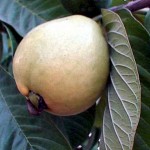 Created on Oahu, Hawaii this Guava generates fruit ideal for juicing. Beaumont is really a energetic plant producing medium-sized (8 oz) fruits along with pink fairly sweet succulent flesh. The trees are usually effective bearing fruit fall through winter.
Created on Oahu, Hawaii this Guava generates fruit ideal for juicing. Beaumont is really a energetic plant producing medium-sized (8 oz) fruits along with pink fairly sweet succulent flesh. The trees are usually effective bearing fruit fall through winter.
This particular South American fruit is widely known through the entire tropics. It’s not fussy around the soil quality, as well as delivers fruit every single year. The aromatic greenish white to white flower, 2.5 cm or even more across, bears several yellow stamens. The fruits are usually adjustable in form, size as well as colour being globular, ovoid, or even pear shaped from 3 to 15cm long as well as the skin might be greenish white, yellowish or even pink. Upon ripening, the guava will become gentle as well as succulent and is also loaded with C vitamin.
4. China White:
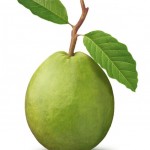 Producing huge (up to a pound) white fleshed & green skinned fruit are extremely sweet & choice. The fruit could be consumed unripe & has got extremely fragrant flesh. These types of Guavas are usually hard & energetic producing fruit September through December.
Producing huge (up to a pound) white fleshed & green skinned fruit are extremely sweet & choice. The fruit could be consumed unripe & has got extremely fragrant flesh. These types of Guavas are usually hard & energetic producing fruit September through December.
5. Mexican Cream:
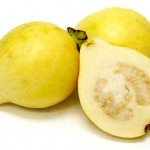 The most effective Guavas all around. This particular Mexican variety features fruit having a good fairly sweet hot and spicy taste. The 8 oz fruit have got cream colored flesh & aromatic yellow skin. The trees produce groups of fruit throughout the fall & winter.
The most effective Guavas all around. This particular Mexican variety features fruit having a good fairly sweet hot and spicy taste. The 8 oz fruit have got cream colored flesh & aromatic yellow skin. The trees produce groups of fruit throughout the fall & winter.
6. Red Malaysian:
 This can be a distinctive selection of Exotic Guava which boats lovely red tinged foliage along with red fruit & pretty bright pink flowers. This particular Guava is eye-catching enough to be cultivated just as one decorative. Tasty fruits mature September through December.
This can be a distinctive selection of Exotic Guava which boats lovely red tinged foliage along with red fruit & pretty bright pink flowers. This particular Guava is eye-catching enough to be cultivated just as one decorative. Tasty fruits mature September through December.
7. South African:
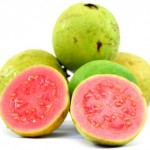 Under appreciated this particular variety comes with a fascinating taste & structure. Bearing delicious cream skinned pink fleshed fruit which feature a gentle flavoring. This particular variety has flesh which can be consumed whenever still crisp. Fruit ripen in autumn.
Under appreciated this particular variety comes with a fascinating taste & structure. Bearing delicious cream skinned pink fleshed fruit which feature a gentle flavoring. This particular variety has flesh which can be consumed whenever still crisp. Fruit ripen in autumn.
8. White Indian:
 From Florida, this specific well-known huge white Guava has fruit develop to a pound. The taste is fantastic & the fruit could be consumed somewhat unripe. White Indian Guavas generates fruit occasionally September through December.
From Florida, this specific well-known huge white Guava has fruit develop to a pound. The taste is fantastic & the fruit could be consumed somewhat unripe. White Indian Guavas generates fruit occasionally September through December.
How to Buy Guavas
- While purchasing guavas, you have to check if the exterior of the fruit is moderately ripe. Look for yellow, white or reddish ones.
- Rounded or oval shaped guavas prove that there are no abnormalities in the fruit itself.
- There must not be any damages on the rind of the guavas since this shows signs of over-ripeness.
- The last criterion is that the fruit should not be soft and subtle. It must be firm and hard to press.
How to store Guava
Guava can be used in juices, sorbets as well as purees yet is barely seen whole within the U.S. There are approximately 150 types of this plum-sized fruit with each having its very own taste. Several are fairly sweet plus some actually have a chocolaty taste. Colors range between yellow to brighter pink as well as everything in between. Guava could be consumed together with the peel or even without and may be also eaten using the delicious seeds within. Retailer guava within the pantry, fridge or even freezer.
- Keep the guava at room temperature, faraway from high temperature or even the sun till the fruit is ripe, about 2 to 5 days. As soon as ripe, reduce and make use of the guava. You’ll know a guava is ripe when it’s gentle to touch.
- Store ripe guava within the fridge for 3 to 4 days. Place the guava, possibly processed or even whole directly into an air-tight, zip-lock plastic bag or even storage container.
- Freeze your guava fruit as soon as it has attained its ripeness or even once it has been within the refrigerator for 3 to 4 days. Cut up the guava into chunks as well as puree within a food processor. You are able to peel the skin from the fruit or even leave it undamaged. Put the puree into freezer safe plastic material containers or even zipper-lock plastic bags. Frozen guava could be saved for Ten to twelve months.
Disadvantage of Guava
Even though the guava fruit contains a large number of health advantages, additionally it is essential to bear in mind its negative effects on overall health. Despite the fact that guavas really are a secure fruit to consume, there’s not sufficient health-related proof to support their usefulness or even safety whenever utilized in medications.
Women that are pregnant as well as breastfeeding moms particularly need to prevent excessive use of guava through numerous herbal as well as choice medicines. It is best to stick to consuming guavas in their normal form so far as probable.
Ways to Eat Guava
Guava juice is actually scrumptious, yet have you ever attempted guava the fruit? It features a distinctive taste that may be very best brought out if consumed effectively. Here is the way to effectively try a fresh new guava!
- Rinse a guava beneath cool flowing water, with no soap.
- Cut out any kind of injured areas together with the tip of the paring knife.
- Cut the guava in half crossways. Make use of a teaspoon to eliminate seed through the middle of the fruit. The guava is just about to consume.
- Serve guava along with ice cream or even natural yogurt, or even cut the guava in small parts as well as combine it with a fruit salad together with orange wedges, sliced up bananas as well as other fresh fruit.
Reference:
https://www.hort.purdue.edu/newcrop/morton/guava.html
https://en.wikipedia.org/wiki/Guava
https://edis.ifas.ufl.edu/mg045
http://aggie-horticulture.tamu.edu/citrus/guava.htm
http://www.britannica.com/plant/guava
https://www.crfg.org/pubs/ff/guava.html
http://www.nutrition-and-you.com/guava.html
http://wiki-fitness.com/guava-health-benefits-and-nutrition-facts/
http://www.foodofy.com/guavas.html
http://www.foodreference.com/html/f-guava.html
http://www.hear.org/pier/species/psidium_guajava.htm
http://davesgarden.com/guides/pf/go/2088/
https://npgsweb.ars-grin.gov/gringlobal/taxonomydetail.aspx?id=30205
http://www.cabi.org/isc/datasheet/45141
Comments
| Guava Quick Facts | |
|---|---|
| Name: | Guava |
| Scientific Name: | Psidium guajava |
| Origin | Southern Mexico into Central America. |
| Colors | Green turning to whitish-yellow or faintly pink when ripe |
| Shapes | Globose, ovoid, or pyriform, 3–10 cm long |
| Flesh colors | Can be white, yellow, pink or red colored depending on the varieties. |
| Taste | Sweet-tart taste. |
| Calories | 112 Kcal./cup |
| Major nutrients | Vitamin C (418.56%) Lycopene (171.74%) Copper (42.22%) Total dietary Fiber (23.42%) Vitamin B9 (20.25%) |
| Health benefits | Weight loss, High blood pressure, Eye & Skin Health, Cough & cold, Brain Health, Beats Toothache, Constipation, Thyroid Health, Diarrhea & dysentery, Scurvy, Immunity, Antimicrobial and Antibacterial, Cancer Prevention, Eyesight, Controls Diabetes, Prevent Fatty Buildup in Arteries, Anti-Inflammatory, Prevention of Gastroenteritis and Diarrhea, Treat and Prevent Diabetes |
| More facts about Guava | |
| Rank | Scientific Name & (Common Name) |
|---|---|
| Kingdom | Plantae (Plants) |
| Subkingdom | Tracheobionta (Vascular plants) |
| Superdivision | Spermatophyta (Seed plants) |
| Division | Magnoliophyta (Flowering plants) |
| Class | Magnoliopsida (Dicotyledons) |
| Subclass | Rosidae |
| Order | Myrtales |
| Family | Myrtaceae (Myrtle family) |
| Genus | Psidium L. (Guava) |
| Species | Psidium guajava L. (Guava) |
| Synonyms |
|


